Page 82 of 570
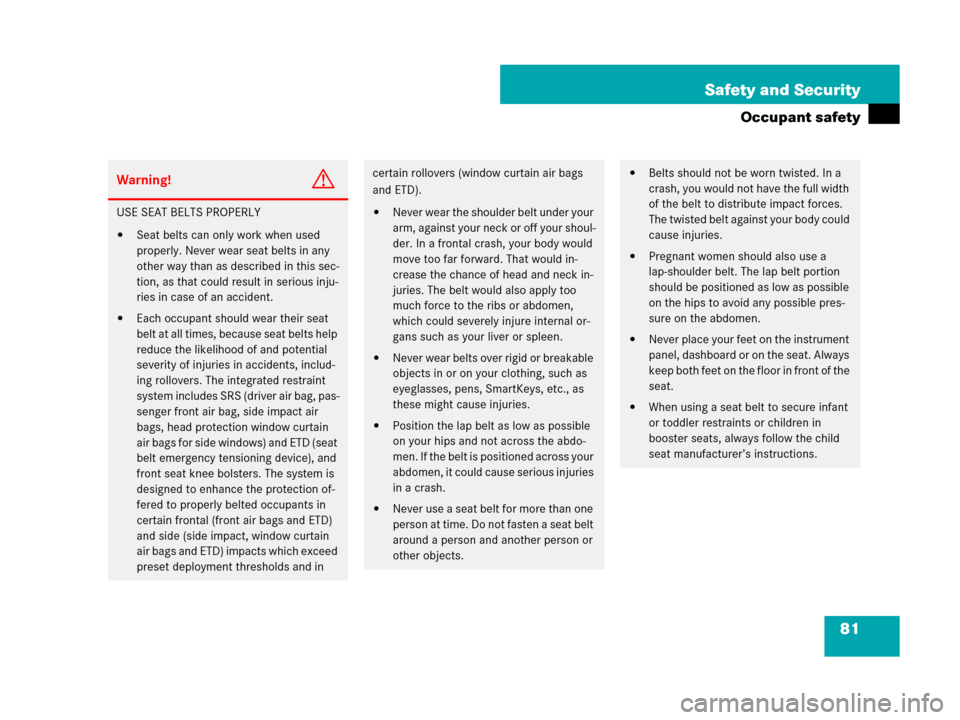
81 Safety and Security
Occupant safety
Warning!G
USE SEAT BELTS PROPERLY
�Seat belts can only work when used
properly. Never wear seat belts in any
other way than as described in this sec-
tion, as that could result in serious inju-
ries in case of an accident.
�Each occupant should wear their seat
belt at all times, because seat belts help
reduce the likelihood of and potential
severity of injuries in accidents, includ-
ing rollovers. The integrated restraint
system includes SRS (driver air bag, pas-
senger front air bag, side impact air
bags, head protection window curtain
air bags for side windows) and ETD (seat
belt emergency tensioning device), and
front seat knee bolsters. The system is
designed to enhance the protection of-
fered to properly belted occupants in
certain frontal (front air bags and ETD)
and side (side impact, window curtain
air bags and ETD) impacts which exceed
preset deployment thresholds and in
certain rollovers (window curtain air bags
and ETD).
�Never wear the shoulder belt under your
arm, against your neck or off your shoul-
der. In a frontal crash, your body would
move too far forward. That would in-
crease the chance of head and neck in-
juries. The belt would also apply too
much force to the ribs or abdomen,
which could severely injure internal or-
gans such as your liver or spleen.
�Never wear belts over rigid or breakable
objects in or on your clothing, such as
eyeglasses, pens, SmartKeys, etc., as
these might cause injuries.
�Position the lap belt as low as possible
on your hips and not across the abdo-
men. If the belt is positioned across your
abdomen, it could cause serious injuries
in a crash.
�Never use a seat belt for more than one
person at time. Do not fasten a seat belt
around a person and another person or
other objects.
�Belts should not be worn twisted. In a
crash, you would not have the full width
of the belt to distribute impact forces.
The twisted belt against your body could
cause injuries.
�Pregnant women should also use a
lap-shoulder belt. The lap belt portion
should be positioned as low as possible
on the hips to avoid any possible pres-
sure on the abdomen.
�Never place your feet on the instrument
panel, dashboard or on the seat. Always
keep both feet on the floor in front of the
seat.
�When using a seat belt to secure infant
or toddler restraints or children in
booster seats, always follow the child
seat manufacturer’s instructions.
Page 89 of 570
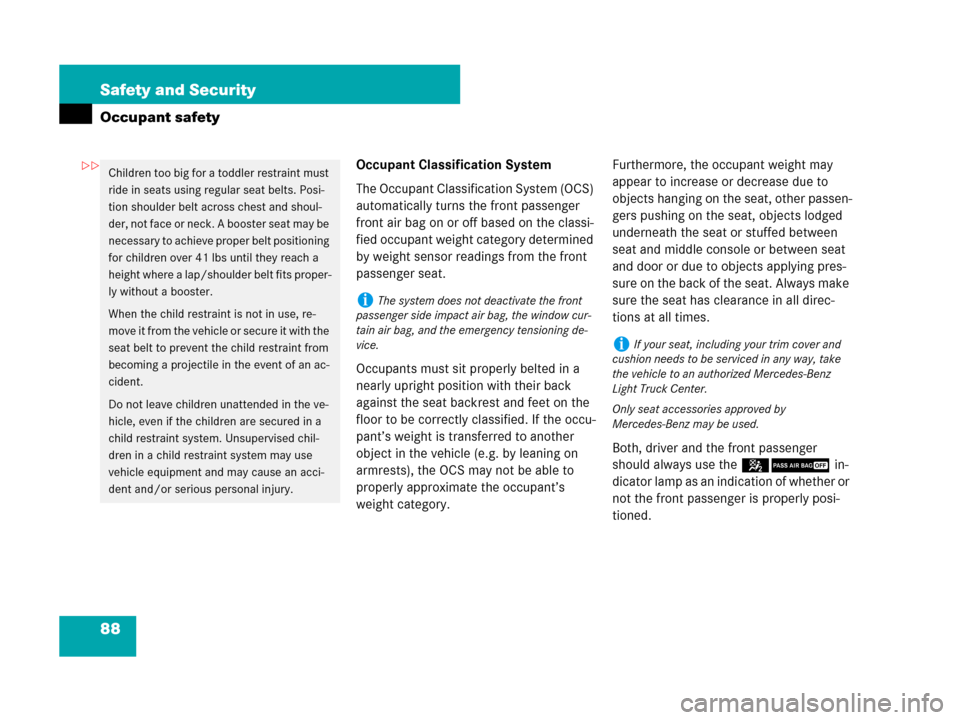
88 Safety and Security
Occupant safety
Occupant Classification System
The Occupant Classification System (OCS)
automatically turns the front passenger
front air bag on or off based on the classi-
fied occupant weight category determined
by weight sensor readings from the front
passenger seat.
Occupants must sit properly belted in a
nearly upright position with their back
against the seat backrest and feet on the
floor to be correctly classified. If the occu-
pant’s weight is transferred to another
object in the vehicle (e.g. by leaning on
armrests), the OCS may not be able to
properly approximate the occupant’s
weight category.Furthermore, the occupant weight may
appear to increase or decrease due to
objects hanging on the seat, other passen-
gers pushing on the seat, objects lodged
underneath the seat or stuffed between
seat and middle console or between seat
and door or due to objects applying pres-
sure on the back of the seat. Always make
sure the seat has clearance in all direc-
tions at all times.
Both, driver and the front passenger
should always use the 59 in-
dicator lamp as an indication of whether or
not the front passenger is properly posi-
tioned.Children too big for a toddler restraint must
ride in seats using regular seat belts. Posi-
tion shoulder belt across chest and shoul-
der, not face or neck. A booster seat may be
necessary to achieve proper belt positioning
for children over 41 lbs until they reach a
height where a lap/shoulder belt fits proper-
ly without a booster.
When the child restraint is not in use, re-
move it from the vehicle or secure it with the
seat belt to prevent the child restraint from
becoming a projectile in the event of an ac-
cident.
Do not leave children unattended in the ve-
hicle, even if the children are secured in a
child restraint system. Unsupervised chil-
dren in a child restraint system may use
vehicle equipment and may cause an acci-
dent and/or serious personal injury.
iThe system does not deactivate the front
passenger side impact air bag, the window cur-
tain air bag, and the emergency tensioning de-
vice.
iIf your seat, including your trim cover and
cushion needs to be serviced in any way, take
the vehicle to an authorized Mercedes-Benz
Light Truck Center.
Only seat accessories approved by
Mercedes-Benz may be used.
��
Page 98 of 570
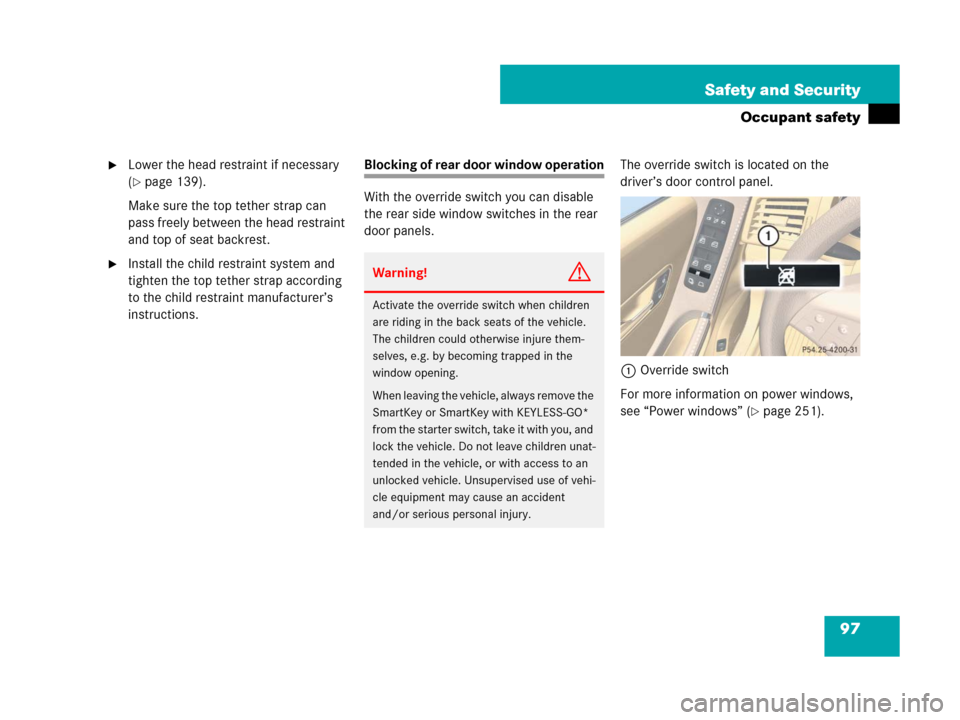
97 Safety and Security
Occupant safety
�Lower the head restraint if necessary
(
�page 139).
Make sure the top tether strap can
pass freely between the head restraint
and top of seat backrest.
�Install the child restraint system and
tighten the top tether strap according
to the child restraint manufacturer’s
instructions.
Blocking of rear door window operation
With the override switch you can disable
the rear side window switches in the rear
door panels.The override switch is located on the
driver’s door control panel.
1Override switch
For more information on power windows,
see “Power windows” (
�page 251).
Warning!G
Activate the override switch when children
are riding in the back seats of the vehicle.
The children could otherwise injure them-
selves, e.g. by becoming trapped in the
window opening.
When leaving the vehicle, always remove the
SmartKey or SmartKey with KEYLESS-GO*
from the starter switch, take it with you, and
lock the vehicle. Do not leave children unat-
tended in the vehicle, or with access to an
unlocked vehicle. Unsupervised use of vehi-
cle equipment may cause an accident
and/or serious personal injury.
Page 99 of 570
98 Safety and Security
Occupant safety
Disabling
�Press override switch1 until it
engages.
The switch engages in the recessed
position.
The rear door windows can no longer
be operated using the switches located
in the rear doors.
Enabling
�Press override switch1 once more.
The switch disengages from its re-
cessed position back to its original po-
sition.
The rear door windows can again be
operated using the switches located in
the rear doors.
iOperating the rear door windows using the
switches located on the door control panel of the
driver’s door is still possible.
Page 112 of 570
111 Controls in detail
Locking and unlocking
Seats
Memory function*
Lighting
Instrument cluster
Control system
Automatic transmission
Good visibility
Climate control
3-zone automatic climate control*
Power windows
Power tilt/sliding sunroof*
Panorama roof with power tilt/slid-
ing panel*
Driving systems
Loading
Useful features
Page 124 of 570
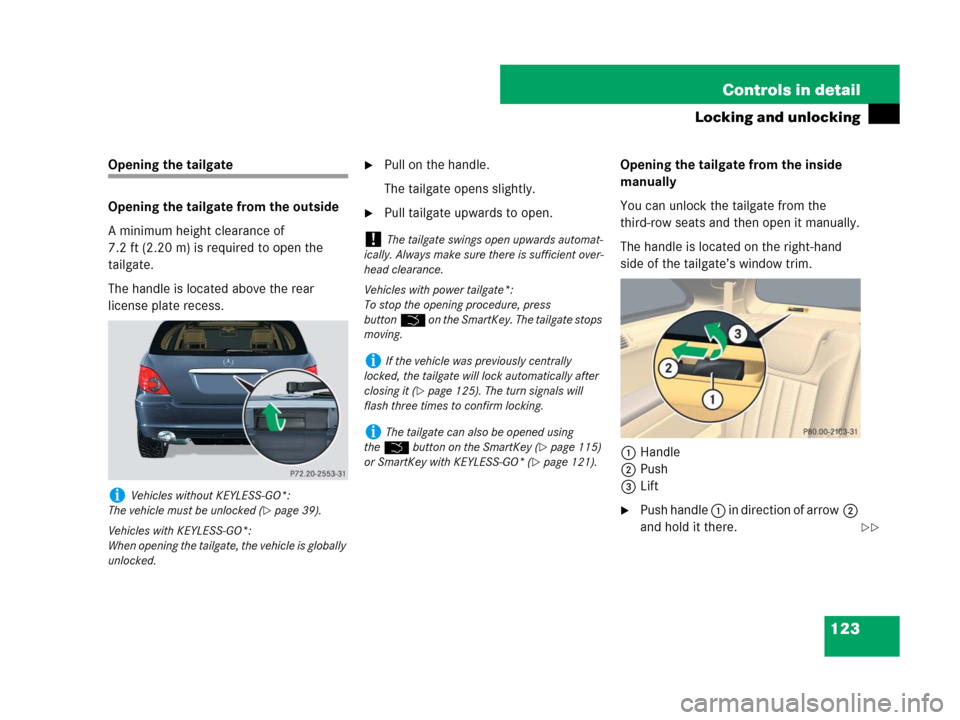
123 Controls in detail
Locking and unlocking
Opening the tailgate
Opening the tailgate from the outside
A minimum height clearance of
7.2 ft (2.20 m) is required to open the
tailgate.
The handle is located above the rear
license plate recess.�Pull on the handle.
The tailgate opens slightly.
�Pull tailgate upwards to open.Opening the tailgate from the inside
manually
You can unlock the tailgate from the
third-row seats and then open it manually.
The handle is located on the right-hand
side of the tailgate’s window trim.
1Handle
2Push
3Lift
�Push handle 1 in direction of arrow2
and hold it there.iVehicles without KEYLESS-GO*:
The vehicle must be unlocked (
�page 39).
Vehicles with KEYLESS-GO*:
When opening the tailgate, the vehicle is globally
unlocked.
!The tailgate swings open upwards automat-
ically. Always make sure there is sufficient over-
head clearance.
Vehicles with power tailgate*:
To stop the opening procedure, press
buttonŠ on the SmartKey. The tailgate stops
moving.
iIf the vehicle was previously centrally
locked, the tailgate will lock automatically after
closing it (
�page 125). The turn signals will
flash three times to confirm locking.
iThe tailgate can also be opened using
theŠ button on the SmartKey (
�page 115)
or SmartKey with KEYLESS-GO* (
�page 121).
��
Page 155 of 570
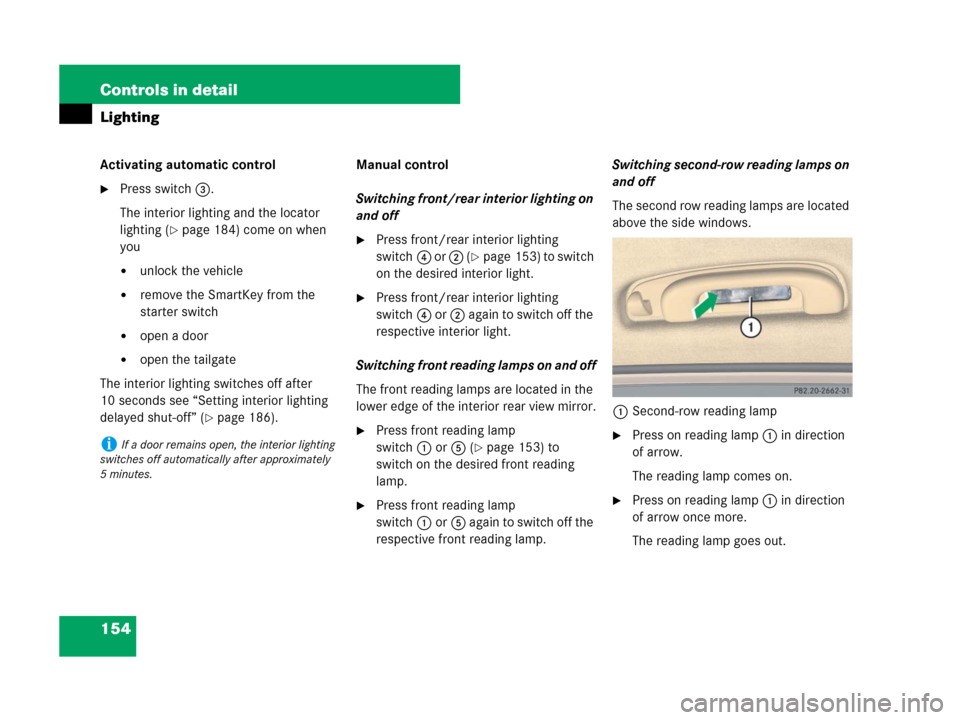
154 Controls in detail
Lighting
Activating automatic control
�Press switch3.
The interior lighting and the locator
lighting (
�page 184) come on when
you
�unlock the vehicle
�remove the SmartKey from the
starter switch
�open a door
�open the tailgate
The interior lighting switches off after
10 seconds see “Setting interior lighting
delayed shut-off” (
�page 186).Manual control
Switching front/rear interior lighting on
and off
�Press front/rear interior lighting
switch4 or 2 (
�page 153) to switch
on the desired interior light.
�Press front/rear interior lighting
switch4 or 2 again to switch off the
respective interior light.
Switching front reading lamps on and off
The front reading lamps are located in the
lower edge of the interior rear view mirror.
�Press front reading lamp
switch1or5 (
�page 153) to
switch on the desired front reading
lamp.
�Press front reading lamp
switch1or5 again to switch off the
respective front reading lamp.Switching second-row reading lamps on
and off
The second row reading lamps are located
above the side windows.
1Second-row reading lamp
�Press on reading lamp 1 in direction
of arrow.
The reading lamp comes on.
�Press on reading lamp 1 in direction
of arrow once more.
The reading lamp goes out.
iIf a door remains open, the interior lighting
switches off automatically after approximately
5minutes.
Page 188 of 570
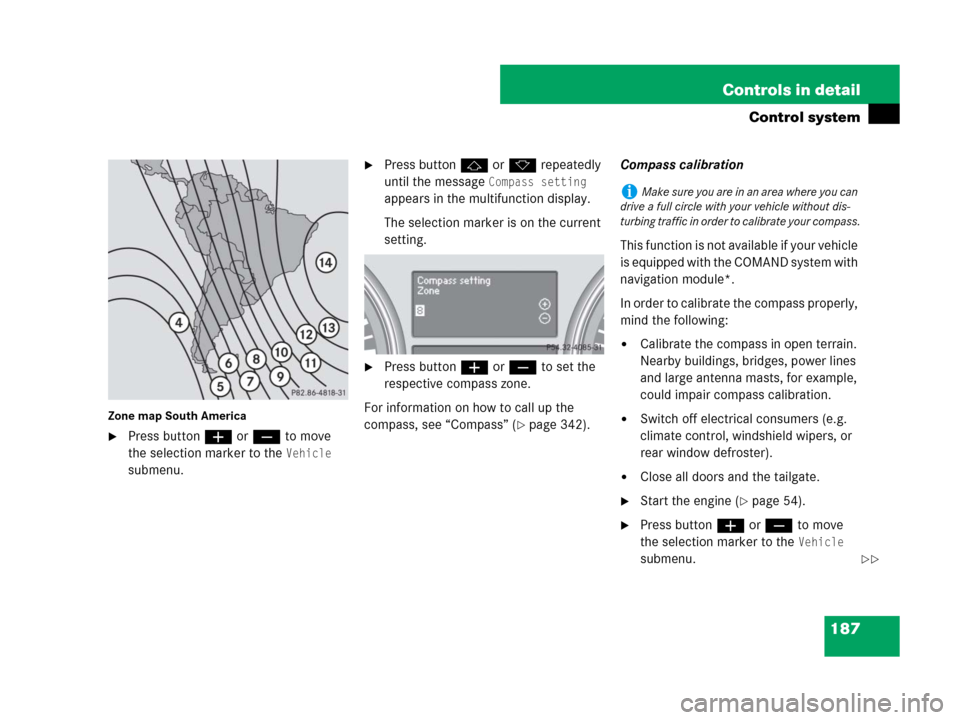
187 Controls in detail
Control system
Zone map South America
�Press buttonæ orç to move
the selection marker to the
Vehicle
submenu.
�Press buttonj ork repeatedly
until the message
Compass setting
appears in the multifunction display.
The selection marker is on the current
setting.
�Press buttonæ orç to set the
respective compass zone.
For information on how to call up the
compass, see “Compass” (
�page 342).Compass calibration
This function is not available if your vehicle
is equipped with the COMAND system with
navigation module*.
In order to calibrate the compass properly,
mind the following:
�Calibrate the compass in open terrain.
Nearby buildings, bridges, power lines
and large antenna masts, for example,
could impair compass calibration.
�Switch off electrical consumers (e.g.
climate control, windshield wipers, or
rear window defroster).
�Close all doors and the tailgate.
�Start the engine (�page 54).
�Press buttonæ orç to move
the selection marker to the
Vehicle
submenu.
iMake sure you are in an area where you can
drive a full circle with your vehicle without dis-
turbing traffic in order to calibrate your compass.
��